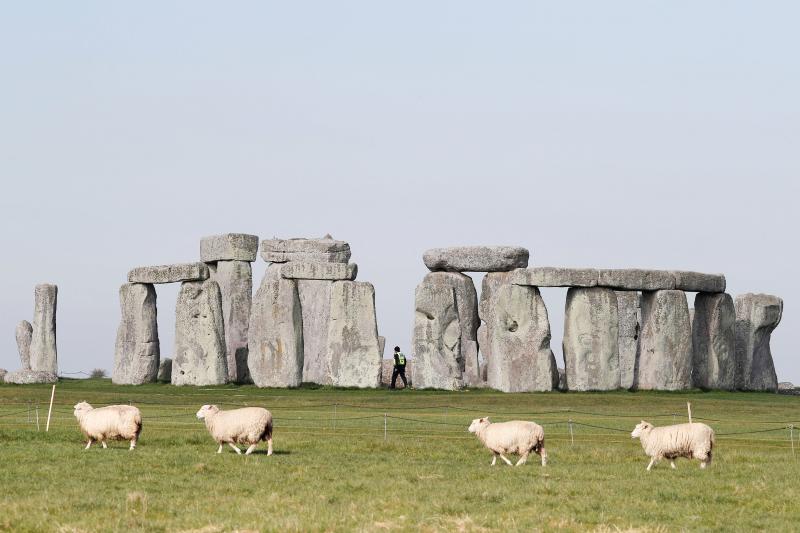Stonehenge, a Neolithic wonder in southern England, has vexed historians and archaeologists for centuries with its many mysteries: How was it built? What purpose did it serve? Where did its towering sandstone boulders come from?
That last question may finally have an answer after a study published on July 29 found that most of the giant stones — known as sarsens — seem to share a common origin 25km away in West Woods, an area that teemed with prehistoric activity.
The finding boosts the theory that the megaliths were brought to Stonehenge about the same time: around 2,500 BC, the monument’s second phase of construction, which in turn could be a sign that its builders were from a highly organized society.

Photo: AFP 照片:法新社
The new paper appeared in the journal Science Advances. Lead author David Nash, a professor of physical geography at the University of Brighton, told AFP he and his team had to devise a novel technique to analyze the sarsens, which stand up to 9m tall and weigh as much as 30 tonnes.
They first used portable x-rays to analyze the chemical composition of the rocks, which are 99 percent silica but contain traces of several other elements. “That showed us that most of the stones have a common chemistry, which led us to identify that we’re looking for one main source here,” said Nash.
Next, they examined two core samples from one of the stones that were obtained during restoration work in 1958 but which then went missing until resurfacing in 2018 and 2019, respectively. They performed a more sophisticated analysis on these samples using a mass spectrometry device, which detects a bigger range of elements at a higher precision.
The resulting signature was then compared to 20 possible source sites for these sedimentary rocks, with West Woods, Wiltshire found to be the closest match. Only the 17th century English natural philosopher John Aubrey had previously postulated a link between “Overton Wood,” probably a former name for West Woods, and Stonehenge.
Previous work has found that Stonehenge’s smaller “bluestones” came from Wales, about 200km to the west, and the new study says that they and the sarsens were placed at the same time. “So it must have been an enormous endeavor going on at that time,” said Nash. “Stonehenge is like a convergence of materials being brought in from different places.”
Just how the early Britons were able to transport the boulders weighing up to 30 tonnes a distance of 25km remains unknown — though the prevailing idea is they were dragged along sleds. The site’s significance also remains mysterious. “I think you’re looking at a very organized society there,” added Nash.
The area was also a hive of Early Neolithic activity. It is home to a huge ancient burial site known as a barrow, a large circular earthwork, prehistoric cultivated fields that are now woodland, and a polissoir — a rock used to sharpen ancient stone axes.
(AFP)
位於英國南部的新石器時代奇觀「巨石陣」,數世紀以來困惑著歷史學家與考古學家:它是如何建造的?它的用途為何?這些高聳的砂岩巨石又是從哪裡來?
七月二十九日發表的一篇研究,可能終於解開前述的最後一個謎團。該研究發現,絕大多數稱為「撒森岩」的巨大石塊,似乎同樣來自於距離巨石陣二十五公里的西伍茲,當地曾經出現過大量的史前人類活動。
這項發現支持巨石約在同一時間被運送到巨石陣遺址的理論:時間大約在西元前兩千五百年,是巨石陣的第二階段建造期,所以也暗示著建造者來自一個高度組織化的社會。
這篇論文日前刊登於期刊《科學先端》,主要作者為布萊頓大學的自然地理學教授大衛‧奈許。他向法新社表示,他和研究團隊必須研發出一項新技術,藉以分析這些高達九公尺、重達三十公噸的撒森岩。
他們一開始使用攜帶型X光機來分析巨石的化學組成,發現其中百分之九十九都是二氧化矽,但是也含有其他幾種元素的跡象。奈許說:「這證明這些石頭大多數都有共同的化學性質,讓我們確認研究團隊正在尋找一個主要來源。」
接著,他們檢驗兩份在一九五八年的維護工程中、從其中一塊巨石獲得的核心樣本。這兩份樣本曾經一度遺失,後來在二○一八年和二○一九年重新浮上檯面。研究團隊運用質譜儀器,以較高的精確度來偵測較大範圍的化學元素,對樣本進行更精密的分析。
分析後巨石呈現的化學特徵,再和二十個可能來源地的沉積岩進行對照,結果發現,位於威爾特郡的西伍茲吻合程度最為接近。在此之前,只有十七世紀的英國自然哲學家約翰‧奧布里有過類似假設,認為「奧弗頓森林」──可能是西伍茲以前的地名──和巨石陣有關。
先前的研究曾經發現,巨石陣中較小的藍岩來自西邊兩百公里外的威爾斯,新研究則指出這些藍岩和撒森岩是在同時期搬來建造的。「在當時,這一定是規模浩大的工程,」奈許表示:「巨石陣就像是一個聚合點,各種石材從不同的地方被帶到此地。」
只是,早期英國人是如何將重達三十公噸的巨石運送到二十五公里外的地方,這仍然不得而知。目前較盛行的看法是:巨石是用長木橇拖到當地。巨石陣的特殊意義也仍是一團謎。奈許補充說:「我想,你眼前看到的是一個非常有組織的社群。」
該地區也是新石器時代早期人類活動的繁忙據點。當地有一個稱為「墳塚」的巨大古代墓葬區,還有一個大型的圓形地景藝術,今日已是一片森林的史前耕地,以及刻有凹槽的沙岩,當時被用來磨利古代的石斧。
(台北時報章厚明譯)

A: Apart from the musical Sunset Boulevard, Japanese pop diva Ayumi Hamasaki is also touring Taiwan after a 17-year wait. She’s holding two concerts starting tonight. B: Ayu has the most No. 1 hits of any Japanese solo artist, with 33 total. A: “Time” magazine even crowned her as “The Empress of Pop.” B: She staged shows in Taipei back in 2007 and 2008, causing an “Ayu fever” across Taiwan. A: Unfortunately, the singer has been deaf in her left ear since 2008, and is gradually losing hearing in her right ear. I’m so excited to see her singing in Taipei again. A: 除了音樂劇《日落大道》,日本歌后濱崎步睽違17年,今晚起在台北熱唱兩場。

Thailand and Cambodia are engaged in their worst fighting in over a decade, exchanging heavy artillery fire across their disputed border, with at least 30 people killed and tens of thousands displaced. Tensions began rising between the Southeast Asian neighbors in May, following the killing of a Cambodian soldier during a brief exchange of gunfire, and have steadily escalated since, triggering diplomatic spats and now, armed clashes. WHERE DOES THE DISPUTE ORIGINATE? Thailand and Cambodia have for more than a century contested sovereignty at various undemarcated points along their 817km land border, which was first mapped by France in 1907 when Cambodia was

Alan Turing, celebrated as the “father of computer science,” was a brilliant mathematician and scientist. Born in London in 1912, Turing showed exceptional talent in mathematics and science from a young age. At 16, he understood Albert Einstein’s work without difficulty. This intelligence carried him through studies at Cambridge University and later at Princeton University in the US, where he further explored complex mathematical theories. In 1936, Turing introduced the concept of the Turing machine, a theoretical device for solving mathematical problems. He described it as having an infinite tape on which symbols could be read, interpreted, and modified. With simple

A: After touring Taipei, the play Life of Pi is now heading to Taichung. You wanna go? B: Did you forget? We’re going to Taipei this weekend to see the musical Sunset Boulevard and go to Japanese pop diva Ayumi Hamasaki’s concert. A: Oh yeah, that’s right. The classic composed by Andrew Lloyd Webber is touring Taiwan for the first time. B: I heard that it’s adapted from a 1950 film with the same title. A: And the show will feature legendary soprano Sarah Brightman, who is finally returning to the musical stage after 30 years. We can’t miss it. A: 在台北巡演後,戲劇《少年Pi的奇幻漂流》本週起將移師台中。要去嗎?